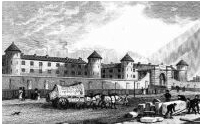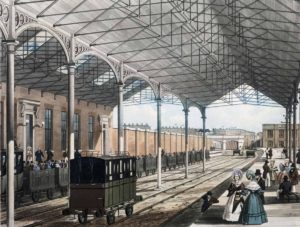Chapter One of 'The Chieftain' (entitled 'The Journey to Scotland Yard') describes George Clarke's early years in the Metropolitan Police Force, a time when London was undergoing great change. The following information, supplementary to that given in the book, provides a more comprehensive picture of the changes that London faced during the period between 1818 when Clarke was born in the rural village of Therfield, and 1862, the year in which he became a Scotland Yard detective.
By the time that Clarke joined the police in April 1840, London had seen a number of significant changes since the year of his birth, including the growth of its population to about 2 million from about 1.4 million twenty years previously. Other changes and events that would have touched on aspects of Clarke’s later life included: the completion of Millbank Prison in 1821.1
The railway era began with the opening of the first passenger railway between Liverpool and Manchester in 1830, the opening of a terminus at Euston by the Birmingham Railway Company in 1837, and the construction of the Paddington to Maidenhead section of the Great Western Railway in 1838.2
In 1832 cholera arrived in London after its first appearance in Britain at Newcastle. In 1831; fire extensively damaged the Palace of Westminster in 1834 and subsequently led to its reconstruction; a forensic test for arsenic was developed in 1836 and the youthful Queen Victoria acceded to the throne on 20 June 1837.
The People’s Charter’ was published a year later amidst the worst economic depression that had ever afflicted Britain (1837-1844).3
From 1840, London continued to move on apace, with many significant events that will have had a direct or indirect bearing on Clarke’s professional and private life. Amongst these, the city had become a somewhat brighter place, with gas lighting having become more or less universal in the streets by 1842. Nelson’s column was completed in 1845.4
The heir to the throne, the Prince of Wales, was born on 9 November 1841 and, married Princess Alexandra of Denmark on 10 March 1863; an event that involved an extra 2037 policemen on duty for the firework display that night.5
Pentonville Prison was opened in 1842; it was intended to be a prison of instruction and of probation rather than one of oppressive punishment, but was probably not seen in that light by its inmates.6
The first decimation of the Irish potato crop by potato blight, occurred in the summer of 1845, yielding an estimated death toll by starvation of 1.1 million Irish men, women and children by 1850, an increase in the number of Irish families emigrating to London and overseas, and an increased moral justification for pro-republican supporters in Ireland that was soon to impact on the police.7
In 1848, several police constables petitioned for a pay increase, with little success.8
On 10 April 1848, the day on which it would be determined whether the English revolution would come or not, the Government effectively crushed Chartism, when fewer demonstrators than expected turned out for a mass meeting at Kennington Common before the third Chartist petition was presented to Parliament. Over 5000 police were on duty that day and more than 7000 troops.9 Clarke and most of the police in the metropolitan force were probably able to say that “I was there!” on that day.
Many diseases that are preventable today were then a major problem; a cholera outbreak had swept across Britain in 1848-49, with mortality estimates of 6,000-15,000 in London alone. In 1853-54 Dr John Snow demonstrated that the disease was transmitted by contaminated water. This forced the Government to improve London’s drainage and sewage outfall, under the leadership of Joseph Bazalgette in the 1860s.10
Bazalgette’s familiarity with the London sewer system was later to be useful to the police during the Fenian conspiracy, in terms of checking for potential terrorist bombs in the sewers beneath public buildings.11
By 1849, the strength of the Metropolitan Police had been increased to almost 5500.12 In 1850 there were 1000 licensed horse-drawn omnibuses operating in London, with each horse adding to London’s stench by excreting an estimated 45 lbs. of faeces and 3.5 lbs. of urine a day.13
In 1851, The Great Exhibition opened in Hyde Park within Joseph Paxton’s ‘Crystal Palace’. It was a huge success with an average daily attendance of 50,000.14
By 1853, photography had started to take off but was still a messy and complicated process.15 In the same year, penal servitude was introduced to substitute for transportation, for sentences between a minimum of five years and a maximum of fourteen.16
On 28 March 1854 Britain declared war on Russia, siding with Turkey, and the Crimean war started; the Charge of the Light Brigade occurred on 25 October that year, led by the Earl of Cardigan, a man who Clarke was later to work for.17
In 1855, the first London pillar box was installed, in Fleet Street; there were approximately 10 postal collections, and 12 deliveries a day.18 A Sunday Trading Bill (potentially restricting trading on that day) created public opposition, leading to skirmishes between demonstrators and the police in Hyde Park; police brutality in suppressing the disorder was widely reported.19 In 1856 a new Police Act appointed a single Metropolitan Police Commissioner (Sir Richard Mayne) and two assistant commissioners.20
In 1859, Charles Darwin published “The Origin of Species”, establishing the concept of ‘natural selection’ as the driving force of evolution, opening a controversy between science and some fundamentalist religious beliefs that continues today.21
In 1860, music-hall entertainment had arrived in Central London in the form of the Royal Alhambra Palace and Music Hall at Leicester Square. 22
By 1861 London's population had increased to approximately 2.8 million.
On the 14 December 1861, Albert, the Prince Consort, died from typhoid fever. Queen Victoria's grief was so profound that she lived as a virtual recluse for several years and performed few constitutional functions. 23
Pickpockets were legion throughout the country and by 1862, an outbreak of 'garroting' - seizing a foot passenger round the neck from behind while an accomplice rifled his pockets - created much attention in the press, panic amongst the public, and problems for the police. 24
1862 was also the twentieth anniversary of the Metropolitan Police force at Scotland Yard, and was the year in which George Clarke started to acquire his detective credentials.
References
PHOTOS (from the top)
1. Millbank Prison on the banks of the River Thames. (Wikipedia: Millbank Prison)
2. The first railway terminus at Euston (Wikipedia: Euston Railway Station)
3. The first photograph of Queen Victoria and her eldest child, Princess Alice (Wikipedia: Queen Victoria)
4. The wedding of Prince Edward and Princess Alexandra (Wikipedia: Edward VII of the United Kingdom)
5. The Irish Potato Famine (Wikipedia: Great Famine (Ireland))
6. The Chartist meeting at Kennington Common (Wikipedia: Chartism)
7. Joseph Bazalgette (Wikipedia: Joseph Bazalgette)
8. Entrance Pavilion to the Great Exhibition (Wikipedia: The Crystal Palace)
9. The Charge of the Light Brigade (Wikipedia: Charge of the Light Brigade)
10. Charles Darwin (Wikipedia: Charles Darwin)
11. The Alhambra, Leicester Square (Wikipedia: Alhambra Theatre)
12. Prince Albert (Wikipedia: Albert, Prince Consort)
Notes: 1. Higgs (2007) p.12; 2. Hart-Davis (2001) pp. 13-4, 206; 3. White (2007) p.10, Wilson (2002) pp.9, 16, 24, 28; 4. White (2007) p. 21-22; 5. The National Archives (TNA) Public Records Office (PRO) MEPO 7/24; 6. Priestley (1999) p.27; 7. Wilson (2002) pp.74-83, White (2007) pp.131-136; 8. Emsley (1996) p.95; 9. Wilson (2002) p. 116, White (2007) pp.131-136; 10. Wilson (2002) pp.36, 151; White (2007) pp.49, 51, 54, 456, 460; 11. TNA:PRO HO 45/7799 part 1; 12. White (2007) p.402; 13. Picard (2005) pp. 3, 31; 14. Picard (2005) pp.212-224, White (2007) p.269, Emsley (1996) p.43; 15. Hart-Davis (2001) p.129; 16. Higgs (2007) pp.9, 16, Emsley (2005) pp.280-282; 17.Wilson (2002) pp.175-199; 18. Picard (2005) p.68; 19. Emsley (1996) p.66; 20. Ascoli (1979) p.122; 21. Wilson (2002) pp. 227, 376; 22. White (2007) p.279; 23. Wilson (2002) pp.236-44; 24. White (2007) p.337, Emsley (2005) p.26.
Bibliography: Emsley, C. (1996) The English Police: A Political and Social History (Second Edition). Longman. Emsley, C. (2005) Crime and Society in England (Third Edition). Pearson Education Ltd. Harlow, UK. Hart-Davis, A. (2001) What the Victorians Did for Us. Headline Book Publishing. Higgs, M. (2007) Prison Life in Victorian London. Tempus, Stroud, UK. Picard, L. (2005) Victorian London; The Life of a City. Weidenfeld and Nicolson. Priestley, P. (1999) Victorian Prison Lives. Pimlico. White, J. (2007) London in the Nineteenth Century; A Human Awful Wonder of God. Random House. Wilson, A.N. (2002) The Victorians. Hutchinson.












